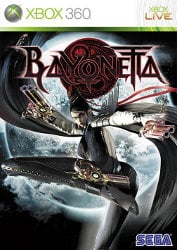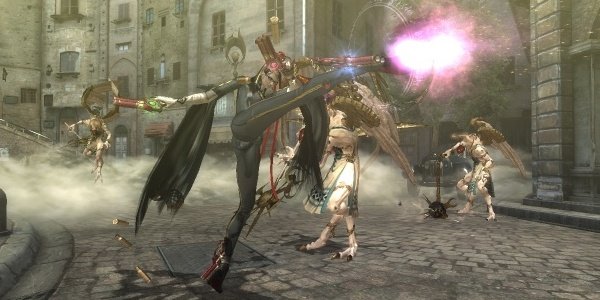
Two shapely women battle angels with guns and karate on the face of a clocktower while it plummets into an abyss. That sounds like a pretty good last battle but it's actually Bayonetta's first scene. Rest assured things get a lot more ridiculous as the game goes on.
The black-haired girl from the first scene is Bayonetta, the last of the Umbra Witches. The Witches are followers of darkness who were all but wiped out in a war with the Lumen Sages 500 years ago. Bayonetta wakes up in the present day with little idea of who she is. Despite her amnesia and the constant flood of Angels (aligned with the Sages, I suppose) attacking her, she's surprisingly nonchalant and playful. Not that there's any reason for her to be worried about the latter; she's a skilled martial artist who can wield four guns at a time (two in her hands, two attached to her ankles). She's able to use a fair bit of magic, too. Her hair, called a "Wicked Weave" I think, can form fists and feet to pummel foes.
No matter your religion, you're not going to feel bad fighting these Angels. Rather than looking like Matt Damon with wings, Bayonetta's Angels are grotesque beings with little to no human characteristics. Though they have traditional "angelic" features - a halo, golden wings, maybe a horn in their hand - they more closely resemble animals or robots. It's an interesting case study of character design: the "good guys" resemble monsters so that you don't feel evil fighting them. They're scary-looking so they must be destroyed.
While I understand why I'm fighting Angels - they look like monsters! - I'm not sure why Bayonetta is. I understand the broad strokes of the story: the balance of light and dark (Sages and Witches) keeps order in the universe and if the dark is extinguishes (i.e. if Bayonetta dies) then bad stuff happens. The scene-to-scene plot eludes me, though. Bayonetta basically just wanders around a city picking fights with progressively stronger Angels. My confusion over the plot is probably due to some combination of A) a rough translation of the script from Japanese to English, B) a jumpy structure, and C) the story doesn't make complete sense. The game resorts to clumsy exposition dumps toward the end to try and tie things together but by then, I had given up attempting to understand. They're scary-looking so they must be destroyed.

Story frustrations are quickly forgotten once combat begins. The four face buttons are used to punch, kick, shoot your gun, and jump. There's an impressive number of combos to uncover, and the game smartly allows you to test them out during loading screens. Successful hits build up your Magic meter and when that's full, you can unleash a Torture Attack. Torture Attacks allow you to finish off a non-boss enemy in one fell swoop. Bayonetta summons some sort of execution device - such as a guillotine - and then jams the hapless enemy into it. You're prompted to swing your analog stick or mash a face button as quickly as possible in order to maximize the amount of halos you earn from it.
Halos are the in-game currency that allows you to buy upgrades. Each chapter of the game is broken up in several smaller "stanzas," some of which only consist of a single small fight. You're graded on your performance in each of these stanzas - how much damage did you take, how quickly did you finish it, etc. - and are awarded an appropriate amount of halos. All of this data is saved by the game to encourage you to replay chapters and beat your best scores.
While learning how to hit enemies is important, equally important is learning how not to get hit. The right trigger button allows Bayonetta to evade, and it's going to be your best friend. Narrowly dodging an enemy attack will activate "Witch Time," a temporary slowdown of the action that essentially allows you to get a few free hits on any nearby foes. The trick with "Witch Time" is that it only kicks in if you evade an attack right before it lands. Dodging two seconds before your enemy attacks won't do it. While this may seem counterintuitive - "Wait, the game's punishing me for reacting to attacks faster?" - what it does is create an interesting risk/reward scenario. In order to get "Witch Time," would you be willing to wait until the last second to duck and risk getting hit? Your health doesn't regenerate between battles and healing items are in short supply throughout the game so each hit you take is a pretty big deal. Enemy damage lowers your Magic bar and reduces your stanza score, as well.
Your Daily Blend of Entertainment News
The combat in Normal, the highest difficulty setting available in your first play-through, is fast and unforgiving. Once you get about two or three chapters into the game, it will really start to steamroll you unless you've figured out the mechanics. That's about where I was when I hit "the wall" and died about ten times in a row. This is really the moment of truth for the player. People who like the trial-and-error of old school, twitch gaming and don't mind trying a fight over and over (first to beat it, and then later to beat their high score) will feel right at home.

There are Easy and Very Easy modes to accomodate more casual players but the drop-off between Normal and Easy is horribly steep. The enemies are slower, you've got more health, the window for "Witch Time" is greater, and - basically, you can beat the game with mindless button-mashing. As I said, the game's story is incoherent so plowing the the game on Easy with just two or three combos isn't going to be very satisfying. Stringing together combos and "Witch Times" to destroy a group of enemies in less than ten seconds is really where the joy of the game comes from, not from seeing Bayonetta defeat the whoever to get the whatever stone.
Bayonetta puts all of its eggs into the combat basket. It has platforming and puzzles like God of War but they're not as well-developed. There's only a small number of puzzles and the vast majority are solved by triggering "Witch Time". The platforming is pretty easy and you risk little; if you fall off a cliff, you immediately respawn at the spot before your last jump with a bit of your health taken off. It's pretty compelling when the game combines platforming with combat, though. During one boss battle, Bayonetta must run along its tentacles while dodging attacks in order to get to the beast's tender parts. Jumping over chasms when you're not in combat, though, feels like more of a relaxing breather than a challenge in and of itself.
The "it's only fun if you're killing stuff" doesn't apply to the handful of vehicle segments spread throughout the game. You'll drive a motorcycle and a missile in the campaign and shoot enemies with your handguns while weaving between obstacles. If not for the next-gen graphics, you'd think you were playing an old school arcade shooter. If you're really intent on giving the game a tug-job, you'll insist that this is an "homage" to 70's and 80's arcade games. Whether or not that's true, the fact remains that these sequences are really repetitive. Each runs about a minute or two longer than it ought to, with players simply dispatching the same enemies over and over in looping environments. It doesn't measure up well with the game's exceptional melee combat.
Bayonetta does only one thing well - combo-based combat - but it happens to do it really, really well. Hand-to-hand fights are beautiful, fast-paced, challenging, and in the end very rewarding if you're patient enough to learn the ropes. If you can't tolerate steep learning curves and don't have an interest in revisiting the 7.5 hour campaign to beat your high scores and unlock the extras, though, it's tough to recommend the game. Before you throw down any money, you should check out the demo and make sure this niche is for you.
Note on versions: By the way, if you own a PS3 and Xbox 360, I'd urge you to pick up the 360 version. Platinum Games outsourced the PS3 port to another studio and it's imperfect. While the two versions are pretty similar, the PS3 tends to have more slow-down during intense combat. The loading times are longer, too. You actually get a 1-2 second loading screen when you try to open the Options menu, with additional loading when you switch between sections of that menu.
Players: 1 Player
Platform(s): Xbox 360 (reviewed), PS3 (reviewed)
Developer: Platinum Games
Publisher: Sega
ESRB: Mature
Rating:

Staff Writer at CinemaBlend.

